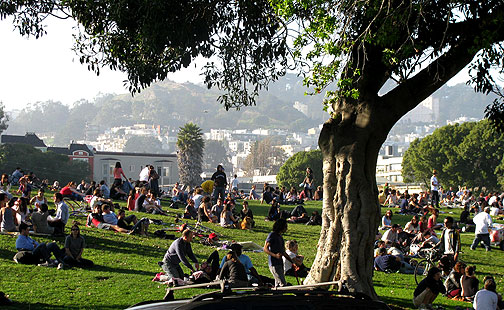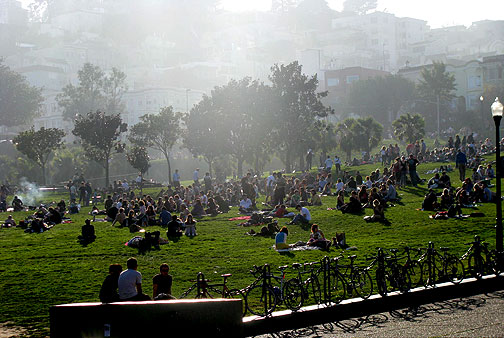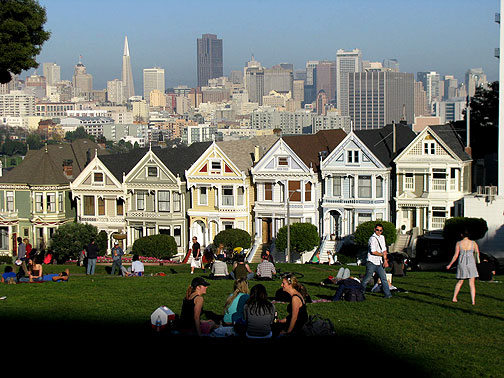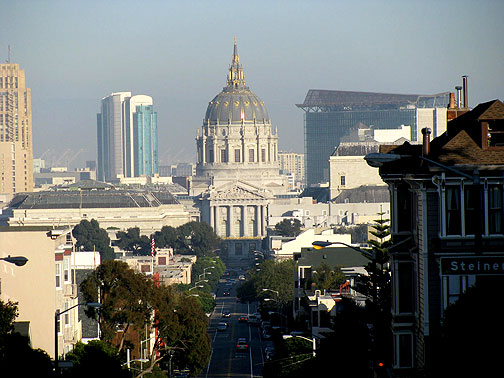I’ve been working on other things, thus dropped the blog-ball a bit lately… one reason is I’ve actually been employed to write 3 blog posts a month over at sf.streetsblog.org, so that’ll get in the way of putting things here. (The Jane Martin piece was the first one.) I agreed that I might re-post some things here after two weeks, but here’s the latest one I did for them on depaving and history.
The REALLY BIG NEWS is that the long-promised Shaping San Francisco wiki is up and running and ready to visit! It’s at FoundSF.org, which we’ve renamed it, in light of our new partnership (not quite signed yet) with the San Francisco Museum and Historical Society. I also posted the Spring Bike Tour calendar in case anyone is waiting for that. And I’m trying to finalize the March-May Talks series, overcoming a number of glitches… will post that here soon.
I’m getting out of town this Friday, heading to Belem, Brazil for the World Social Forum, and when I get back on Feb. 4, I will only get up again the next morning to head to Los Angeles where I have a bunch of Nowtopia appearances lined up til I finally come home late on Feb. 9.
Meanwhile, the weather here in San Francisco, while I was expecting to be indoors continuously, has been eerily summer-like. Here’s some shots I took at random last Saturday, late in the day, as I rode over to the lower Haight. First a couple of shots of Dolores Park, nowadays chock full of young hipsters whenever the weather is suitable…

Dolores Park, January 17 09, wintery light, summery air, just north of 19th Street.

Winter light pours over Liberty Hill onto sunbathing denizens on the slopes above 19th Street in Dolores Park, Jan. 17, 2009.
After that I ended up over at Alamo Square and took this iconic photo, happily with humans in it for a change, followed by a strange look at City Hall due to the new architectural landmarks that sprouted behind it in the past few years.

The most typical SF photo... Alamo Square towards Downtown.

SF City Hall from Fulton Street next to Alamo Square. Federal Bldg to right and new turquoise hotel at 5th and Howard to left.
Another task on my plate is to finish a rewrite on an article I’ve been collaborating with Francesca on, for Antipode magazine, called “Nowtopia: Strategic Exodus?” The new writing has to address the “virtual spine of the commons” as I dubbed it in the book, the net, but also networking more broadly. On my way to the World Social Forum, I’m acutely aware of what an abundance of writing and thinking is going on covering the broad topic of networking politics. A couple of interesting articles I read were Social Movements 2.0 by Brendan Smith, Tim Costello & Jeremy Brecher, and The Alternative’s Alternative by Evgeny Morozov. Smith and Costello spoke at a recent Networking Politics conference I attended at Berkeley, and I really appreciated their argument, most of which is reprised in this piece at the Nation. A key to their ambivalent embrace of new online networks is that so far, it’s easy enough to get huge numbers of people to sign petitions and donate money, but really rare to translate such behaviors “into solidarity built on trust and a willingness to take economic or physical risk on another’s behalf.”
“We’re drawing closer to the point where the majority of online tools are so simple that technical experts are beginning to fade into the background. The web is no longer the exclusive dominion of the young and highly educated, and as this trend continues it will allow social movements to cheaply and easily reach out to increasingly diverse constituencies.”
But along with these transformations they correctly note that existing organizations, often quite hierarchical and top-down, will have to cede control to self-organizing individuals. I recall ten years ago when I was working on the first iteration of the ILWU website (they later hired some big firm to do a revamp) there was a great deal of confusion and nervousness about how to present the union on-line. At the time some union leaders were quite resistant to even including the union’s constitution on line, and to this day, they are hostile to an open forum where members can speak to each other directly on the union’s official site. As the authors put it: “The destruction of hierarchies online means that top-down organizations will face increasing pressure from members to permit more rank-and-file debate and input. This is a healthy process and a long time in coming… Organizations that resist this trend will become increasingly irrelevant online and offline.”
The Morozov article, addressing the upheavals in Greece, comes at some of the same issues from a different angle, looking at how the social movements we tend to see as cutting-edge are themselves being outflanked by the new social software tools:
“…close observers of the riots on the Internet could not help noticing that the anti-globalists ““ the usual suspects of any loud public mischief ““ were hardly visible in the virtual space. This could have been strategic: their members may have preferred to act behind the curtains and avoid publicity. Yet another explanation is also possible: professional anti-globalists have simply been outnumbered by thousands of “freelance radicals”, who have skilfully exploited the Internet, bypassing the cantankerous anti-globalist media in its entirety raising many questions about its usefulness and its future role…
As access to the Internet became more widespread, the anti-globalization activists from all over the world found themselves connected to its giant protest grid and it seemed logical to build a lean, fast, and cheap reporting network to take advantage of it…The most impressive of such networks- the Independent Media Center (or Indymedia)– sprang up in the wake of the Seattle anti-WTO protests of 1999, acquiring a cult status in the anti-globalization community overnight. Since then, Indymedia has been busy supplying their contributors with reporting equipment, organizing media trainings, and helping their stringers get their stories out to the general public. The years that followed – with a plenty of protest action around WTO and G8 summits – marked the renaissance of the alternative media.However, by 2008 the usefulness of such initiatives seems less obvious; what looked novel in 1999 looks unnecessarily centralized and hierarchical today.”
It’s a fascinating moment in history. Just as the economy is collapsing, and old systems seem to reaching their logical conclusion, there’s a weird kind of yearning for old, known answers. Hence the frenzy these past days (around here anyway) for the Obama inauguration (I guess it goes to show how out of touch I am with mass culture… I don’t feel a thing beyond a mild curiosity to see how few weeks or months it takes for his popularity to plummet and the gauze over people’s eyes to fall away…), and this weirdly naive, disconnected sense of hopeful optimism… for a Democrat? A guy who has appointed entirely old guard criminals and incompetents? Wow, talk about suspending disbelief!
But the new epistemology, which is only going to get really interesting when it starts to find a political voice beyond endless adhocracy, indicates that historic agency is now less organizational and more individual, but as individuals aggregate online and off, they will confront many old familiar problems that organization builders and organizers in general have had to face in years past. The real reason for hopefulness right now, for me, is that more and more people are asserting themselves in various ways, and not just leaving it to the traditional structures and forms. To be sure, they constitute a small minority in the broad population, but in the fissures and uprisings that are appearing, there is an urgency, an untried sense of possiblity for whole new ways of self-organizing. I’ve often pointed to Global Guerrillas, and here I go again, but his writings on the rise of new kinds of super-empowered individuals and groups also reinforce the sense that historic agency has shifted downward. Oddly, it is close to the age-old anarchist fantasy of a society run from below, horizontally, and on an as-needed basis… Perhaps Ad-hoc-cracy is a fine model to embrace at this moment of great pressure and unknown futures?…












I have to agree completely about the Obama frenzy. Even an “anarchist” I know seems to have gotten caught up in it. While less common, that hopeful optimism is even more jarring out in this part of the world, where Obama managed to alienate a good number of people with his very first appointment of a Zionist to his cabinet. Somehow his middle name seems to mean more than that to a lot of people.